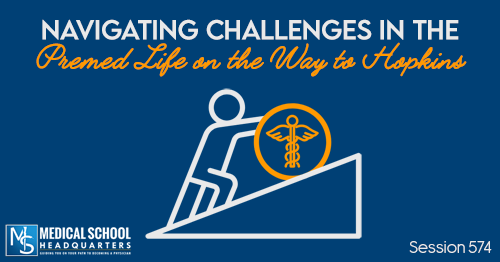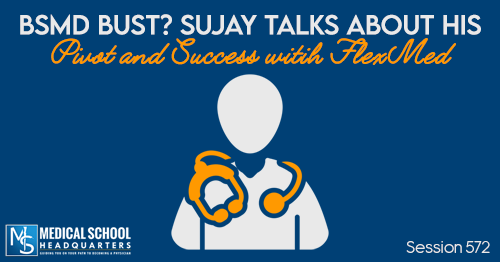Apple Podcasts | Google Podcasts
Session 504
Guest and Author, Dr. Brian Elliot shares his intel on how we tend to cling to traditions in the medical field as well as how we can forge a path forward. We talk about his book, White Coat Ways: A History of Medical Traditions and Their Battle with Progress.
For more podcast resources to help you with your medical school journey and beyond, check out Meded Media.
Listen to this podcast episode with the player above, or keep reading for the highlights and takeaway points.
[01:21] The MCAT Minute
The MCAT Minute is brought to you by Blueprint MCAT.
The whole point of this journey is to test you to make sure that you can handle what’s to come in medical school, residency, and everything else. And one of those ways of testing you is to see if you can juggle classwork, extracurricular activities, MCAT prep, and all that fun stuff.
One of the best ways to make sure that you’re ready for that MCAT prep is to plan your work. Use the free study planner tool from Blueprint MCAT to help you with that planning. Plan out your study plan based on your specific individual needs, how much work you have, how much family time you have, or whatever that may be.
[03:08] Interest in Becoming a Physician
Brian says he didn’t come into college thinking he wanted to do medicine. In fact, he started wanting to do physical therapy. As he started taking Physiology classes and the like, he then saw medicine as the perfect way to just get as much medicine as he could.
He wanted more than just musculoskeletal things. He wanted cardiac and all the other systems. He wanted to really dive in.
[04:37] Taking Time to Smell the Roses
Brian acknowledges the stress that premeds have to put on themselves with so many things to do – MCAT, classes, personal statement, letters of recommendation. And sometimes, you forget to stop and smell the roses.
The system is certainly designed for that competition. But even after you get into med school, when you get into residency, people often find themselves just putting their heads down and not enjoying what they’re doing.
Not enough people take those small wins and victories and applaud themselves and give themselves credit. They only look at all the years they need to spend to become a doctor. And that’s all they think about.
[07:31] The Impetus Behind Writing the Book
Having gone through the white coat ceremony, reciting the Hippocratic Oath and all that stuff, Brian started looking into those traditions. These are 3,000-year traditions, and he’s questioning why we’re still using them now.
He then wrote an article, and then the article turned into a really long article. And then he realized there were a lot more traditions. So he took the seven most common and then turned those into a book.
[08:22] Where “Do No Harm” Comes From
The phrase “do no harm” is actually not in the Hippocratic Oath. But it comes from Hippocrates’ book, Of the Epidemics.
It’s a separate thing written in the Hippocratic Corpus, which is this body of work that we attribute to the Hippocratic physicians. The Hippocratic Corpus wasn’t just written by one guy, or at least that’s what most scholars agree on.
The Hippocratic Oath wasn’t written by any of them, not even a Hippocratic physician. And that’s a common misconception.
So ‘do no harm’ actually, is more related to Hippocrates than the actual Hippocratic Oath. When scholars look at the content of the initial Hippocratic Oath, it’s a lot more in line with some other beliefs from other sects of medicine at the time. So it’s more believed to be related to Pythagoras and his followers.
[10:20] Brian’s Area of Focus
Brian says he focuses mostly on Hippocrates and after, which is really not even the true beginning. Even the Egyptians did burr holes where they drill a hole into the cranium to drain blood from the surroundings outside the brain. And there’s evidence that even the Egyptians did something similar back in the day.
So they had a surprisingly impressive knowledge of medicine sometimes. At other times, it’s wild the harmful things that they did. It really goes both ways.
[11:42] A Look into the History of DO
Andrew Taylor (A.T.) Still, the founding father of osteopathy went rogue after his kids died, which is totally reasonable. He had three children that died of meningitis, and then he invited a doctor to come help treat them along the way. And when that doctor failed, he lost faith. It wasn’t effective because they didn’t have antibiotics for meningitis back then.
As a result, he came up with his own ideology, which was that the seat of disease was in the spine and some other concepts that go along with that.
He basically took that ideology and started his own school in Missouri. And as the charismatic person that he was, people listened. And this was an era where medicine wasn’t the scientific method all around.
There were so many different types of physicians such as homeopaths, eclectics, etc. This was back in the 1800s. His school was chartered in 1891. He quickly got traction and got about 700 medical students, by the turn of the century.
[14:04] A Look Into the MD World Back Then
A.T. wasn’t living modestly by any means. Brian thinks A.T. Still and D.D. Palmer, who founded chiropractic around the same time, are both very interesting.
All these medical organizations were a bit culty back then, as Brian would describe it. They idolized their one leader and they had this set of beliefs. It was basically medicine on an ideology and not how we do it today. Today, we base it on methodology and the scientific method. We do randomized controlled trials and studies, which are going to show us what’s true and what’s effective.
But even the MDs were just getting into that scientific revolution so they weren’t doing the right things back then either. The MDs were fighting with A.T. Still and D.D. Palmer, but they were also fighting with themselves.
They had the same transition at the turn of the century. In 1910, the Flexner Report came out. And even before that, there were tons of licensing rules that started to go into play to cut out all the low-tier physicians at the time who were really terrible at their job.
'Medical school back then was whatever you wanted it to be. You could go to medical school and graduate in six months because there was no regulation.'Click To TweetIt was a ton of for-profit medical schools, churning out low-tier physicians. And it wasn’t until they trimmed out those low-tier physicians in the early 1900s, that everything changed.
[16:42] The Flexner Report
The Flexner Report started with licensing and the ACGME was founded around the same time too. They put forth rules like a medical school has to be three years long. It has to have anatomy, physiology, etc. state-by-state. Some of the schools couldn’t keep up because they were for-profit organizations that relied on tuition.
In 1910, Abraham Flexner, who was big on medical education, toured the country and visited 155 medical schools. He trashed nearly all of them and revealed the money-making machines. He praised only a handful and wanted to cut them down to about 30 medical schools.
No one was really altruistic in this journey. Because what they were essentially arguing for was a monopoly. It was saying that they want to be the only provider.
Interestingly, osteopathic medicine survived that monopoly. There were a lot of antitrust lawsuits, one from chiropractic about 50 years ago, saying they can’t do this. They can’t be the only providers out there. While it did push quite a bit of a monopoly, it also converted osteopathic medicine to what it is today, which is scientifically based.
And today, with so many things going on, he believes you just have to wait until science. There are plenty of randomized controlled trials showing that those things don’t work. But certainly, we need a little bit of fringe provider to push forward things that eventually do work.
'It's really about waiting until you see what the science says. And then following the science, not just following people who count things for their own benefit.'Click To Tweet[22:59] The Most Interesting Things He Found in His Research
For Brian, the most commonplace misconception he saw was the Hippocratic Oath. The most ridiculous thing he saw was John Brinkley, a self-attributed physician around the same time as A.T. Still and D.D. Palmer. Brinkley felt that he could treat low testosterone by implanting goat testicles into his patients.
Another interesting thing is a chapter on the Hippocratic Oath. It goes into the Nazis and some of the horrible things that they did where they would just freeze people and rewarm them and experiment with that. That bred the Declaration of Geneva, which came right afterward, which was one of the many iterations of oaths and creeds that physicians tried.
[27:03] The History of the White Coat Ceremony
Joseph Lister, who was a physician in Europe, started saying that if we decrease the germs, then the infections at surgical sites will go down. And so history goes a lot into that. At the end of the 1800s, there was a movement and there were a few early photos from Mass General and the Agnew clinic in Philadelphia that show surgeons were the ones to start wearing white coats, and things got caught on from there.
A New Meaning
Now, the white coat ceremony is all about humanism. It was a good transition that happened just a couple of decades ago. And fairly recently, we’ve taken that initial meaning of being antisepsis, knowing it’s not true, and we changed it up a little bit.
But Still, Why Do We Have to Wear Those?
But personally, though, why are we still doing all of these things? We’re out there doing some amazing work as doctors. And to put ourselves up on a pedestal is to say we have to wear this uniform that we know is not good for people. It’s just to show people we’re in a white coat.
Brian explains how people get so attached to the status quo. Some of the backlashes that happened in Europe when they cut out white coats for the “bare below the elbow” policy are just crazy.
The white also serves as a psychological barrier between the doctor and the patient. And so when you go in and you’re wearing your white coat, the patient automatically thinks the doctor is better than them and they feel they’re at a lower level. It puts them at a different level psychologically, that they’re not comfortable sharing things.
Brian adds that psychiatry and pediatrics especially have gone away from the white coat for that reason. It’s standoffish, a little bit, and a little paternalistic to the patient.
We’re All Missing the Point Here
And for the people who do ditch the white coat, your classic Patagonia jacket, the new “white coat” is still covered with germs. It’s the fact that you’re wearing something every day all day, and not washing it. We forget the original point. The point was to be clean.
[34:25] Showing Empathy to Patients
We’re in a period of time now with the pandemic where anti-science, anti-expert, anti-physician, anti-vaccine, and anti-everything is the fun soup of the day.
Brian says this is an existential question that is healthcare’s issue right now. Part of it is being real and transparent with the patients. We have to appreciate their point of view.
From a historical side, there are a lot of reasons to doubt mainstream medicine. There have been bad things done. We certainly don’t do those things anymore. But being transparent with what we’re doing and why we’re doing it is a good start.
We shouldn’t put patients down for googling their symptoms and coming to us with the information they gathered. We have to be okay with them coming in and doing their own research because that’s what they’re going to do.
We have to keep those lines of communication open and have empathy for their frustration with the system and their fears. We have to be empathetic to that, or else we’re just going to continue to drive a wedge.
[37:01] Final Words of Wisdom
Brian hopes that students look at the things that they’re going to see along the way – and also ask why, and make sure that they get a good answer for it.
'Just because we've always done it that way, is not a good reason for doing things in health care.'Click To Tweet











